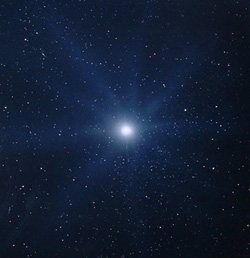June 28, 2004
RAS Press Notice PN04-2

An artist's impression of the young, extremely hot white dwarf star H1504+65, as viewed from a distance similar to that of the Earth from the Sun.
(Illustration: Univ. of Leicester).
An international team of astronomers, studying the left-over remnants of stars like our own Sun, have found a remarkable object where the nuclear reactor that once powered it has only just shut down. This star, the hottest known white dwarf, H1504+65, seems to have been stripped of its entire outer regions during its death throes leaving behind the core that formed its power plant.
Scientists from the United Kingdom, Germany and the USA focused two of NASA's space telescopes, the Chandra X-ray Observatory and the Far Ultraviolet Spectroscopic Explorer (FUSE), onto H1504+65 to probe its composition and measure its temperature. The data revealed that the stellar surface is extremely hot, 200,000 degrees, and is virtually free of hydrogen and helium, something never before observed in any star. Instead, the surface is composed mainly of carbon and oxygen, the 'ashes' of the fusion of helium in a nuclear reactor. An important question we must answer is why has this unique star lost the hydrogen and helium, which usually hide the stellar interior from our view?
Professor Martin Barstow (University of Leicester) said. 'Studying the nature of the ashes of dead stars give us important clues as to how stars like the Sun live their lives and eventually die. The nuclear waste of carbon and oxygen produced in the process are essential elements for life and are eventually recycled into interstellar space to form new stars, planets and, possibly, living beings.'
Professor Klaus Werner (University of Tübingen) said. 'We realized that this star has, on astronomical time scales, only very recently shut down nuclear fusion (about a hundred years ago). We clearly see the bare, now extinct reactor that once powered a bright giant star.'
Dr Jeffrey Kruk (Johns Hopkins University) said: 'Astronomers have long predicted that many stars would have carbon-oxygen cores near the end of their lives, but I never expected we would actually be able to see one. This is a wonderful opportunity to improve our understanding of the life-cycle of stars.'
The Chandra X-ray data also reveal the signatures of neon, an expected by-product of helium fusion. However, a big surprise was the presence of magnesium in similar quantities. This result may provide a key to the unique composition of H1504+65 and validate theoretical predictions that, if massive enough, some stars can extend their lives by tapping yet another energy source: the fusion of carbon into magnesium. However, as magnesium can also be produced by helium fusion, proof of the theory is not yet ironclad. The final link in the puzzle would be the detection of sodium, which will require data from yet another observatory: the Hubble Space Telescope. The team has already been awarded time on the Hubble Space Telescope to search for sodium in H1504+65 next year, and will, hopefully, discover the final answer as to the origin of this unique star.
This work will be published in July in the 'Astronomy & Astrophysics' journal.
The Chandra X-ray Observatory and the Far Ultraviolet Spectroscopic Explorer (FUSE) were both launched into orbit by NASA in 1999. Their instruments make use of a technique called spectroscopy, which spreads the light obtained from astronomical objects into its constituent X-ray and ultraviolet 'colours', in the same way visible light is dispersed into a rainbow naturally, by water droplets in the atmosphere, or artificially, by a prism. When studied in fine detail each spectrum is a unique 'fingerprint' which tells us what elements are present and reveals the physical conditions in the object being studied.
MEDIA CONTACTS
Jacqueline Mitton
Royal Astronomical Society Press Officer
tel: +44 (0)1223-564914


